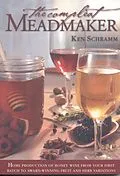Since the publication of The Compleat Meadmaker, mead has enjoyed a remarkable resurgence in the United States. In 2003, there were roughly 60 commercial meaderies; by 2020, that number had grown to nearly 500. This growth reflects not just commercial success but also the passion of hobbyists discovering the joys of crafting their own "nectar of the gods". Mead?fermented honey and water?is among humanity's oldest alcoholic beverages, with deep roots in ancient cultures across Europe, Africa, and Asia. Its simple ingredients and intoxicating charm made it a staple of rituals and celebrations. Although mead's popularity faded with the rise of beer, wine, and spirits, the modern craft beverage movement has brought it back into the spotlight, alongside artisanal beers and wines. A central figure in this revival is Ken Schramm, veteran meadmaker and co-founder of the Mazer Cup Mead Competition, North America's premier mead-only event. In The Compleat Meadmaker, Schramm introduces readers to the craft with clear instructions and straightforward recipes. He guides beginners through their first batches and then explores more advanced styles using spices, fruit, grapes, and malt. The book is a comprehensive guide covering:
- Equipment and Basics ? The tools and steps to make your first mead.
- Fermentation Techniques ? Choosing yeast, managing pH, aeration, and nutrients.
- Flavor Balancing ? Adjusting acidity, sweetness, and alcohol to taste.
- Clarification and Bottling ? How to clarify, bottle, and store mead properly.
- Aging and Conditioning ? Using oak and time to build complexity.
- Melomel ? Mead with fruit
- Cyser ? Mead blended with apple cider
- Pyment ? Mead with grapes or grape juice
- Metheglin ? Spiced or herbed mead
- Braggot ? Mead with malt, bridging beer and mead traditions
Autorentext
By Ken Schramm
Inhalt
Table of Contents
Acknowledgements
Foreword
Part One: Background
1. From the Beginning to a Modern Revival
2. Defining the Styles
Part Two: Process
3. Changing Honey into Wine
4. Beyond the Basics
5. Yeast and Fermentation
6. Conditioning, Aging, and Using Oak
Part Three: Ingredients
7. All About Honey
8. Fruit and Melomel
9. Grapes and Pyment
10. Spices and Metheglin
11. Grains and Braggot
Part Four: Recipes
12. Putting the Process and Ingredients Together
13. Appreciating Your Mead
Appendix 1: Honey and Other Suppliers
Appendix 2: Conversion Charts
Glossary
Bibliography
Index
